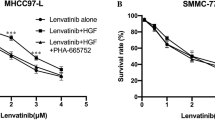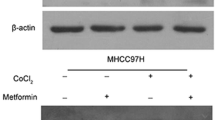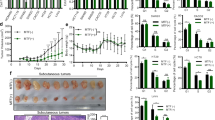Abstract
Metformin has been shown to exert anti-cancer activities in several cancer cells and animal models. However, the molecular mechanisms of its anti-metastatic activities remain poorly understood and warrant further investigation. The aims of this study were to evaluate the ability of metformin to inhibit the migration and invasion of hepatocellular carcinoma (HCC) cells and identify its effects on signaling pathways. Our data indicate that metformin inhibits the migration and invasion of human HCC cells. Metformin was also found to significantly inhibit the expression and secretion of MMP-9 and uPA in HCC cells, and suppress the phosphorylation of ERK1/2 and JNK1/2. Treatment with an ERK1/2 inhibitor (PD98059) or JNK1/2 inhibitor (SP600125) enhanced the inhibitory effects of metformin on the migration and invasion of HCC cells. Moreover, metformin-induced inhibition of MMP-9 and uPA promoter activity also blocked the nuclear translocation of NF-κB and its binding to the MMP-9 and uPA promoters, and these suppressive effects were further enhanced by PD98059 or SP600125. Moreover, metformin markedly enhanced the anti-metastatic effects of sorafenib. In conclusion, metformin inhibits the migration and invasion of HCC cells by suppressing the ERK/JNK-mediated NF-κB-dependent pathway, and thereby reducing uPA and MMP-9 expression. Additionally, combination treatment with metformin and sorafenib yielded synergistic inhibitory effects in suppressing cell migration and invasion of HCC cells. These findings provide insight into the molecular mechanisms involved in the anti-metastatic effects of metformin, as well as its ability to enhance the chemosensitivity of HCC cells to sorafenib.








Similar content being viewed by others
Abbreviations
- ChIP:
-
Chromatin immunoprecipitation
- HCC:
-
Hepatocellular carcinoma
- MMP-9:
-
Matrix metalloproteinase-9
- qRT-PCR:
-
Quantification reverse transcriptase-polymerase chain reaction
- MTT:
-
3-(4,5-Dimethylthiazol-2-yl)-2,5-diphenyl-tetrazolium bromide
- NF-κB:
-
Nuclear factor-κB
- uPA:
-
Urokinase-type plasminogen activator
References
Beckner ME, Gobbel GT, Abounader R, Burovic F, Agostino NR, Laterra J et al (2005) Glycolytic glioma cells with active glycogen synthase are sensitive to PTEN and inhibitors of PI3 K and gluconeogenesis. Lab Invest 85(12):1457–1470
Ben Sahra I, Laurent K, Loubat A, Giorgetti-Peraldi S, Colosetti P, Auberger P et al (2008) The antidiabetic drug metformin exerts an antitumoral effect in vitro and in vivo through a decrease of cyclin D1 level. Oncogene 27(25):3576–3586
Blasi F, Sidenius N (2010) The urokinase receptor: focused cell surface proteolysis, cell adhesion and signaling. FEBS Lett 584(9):1923–1930
Buzzai M, Jones RG, Amaravadi RK, Lum JJ, DeBerardinis RJ, Zhao F et al (2007) Systemic treatment with the antidiabetic drug metformin selectively impairs p53-deficient tumor cell growth. Cancer Res 67(14):6745–6752
Chang Q, Zhang Y, Beezhold KJ, Bhatia D, Zhao H, Chen J et al (2009) Sustained JNK1 activation is associated with altered histone H3 methylations in human liver cancer. J Hepatol 50(2):323–333
Chen TM, Lin CC, Huang PT, Wen CF (2011) Metformin associated with lower mortality in diabetic patients with early stage hepatocellular carcinoma after radiofrequency ablation. J Gastroenterol Hepatol 26(5):858–865
Chen HP, Shieh JJ, Chang CC, Chen TT, Lin JT, Wu MS et al (2013a) Metformin decreases hepatocellular carcinoma risk in a dose-dependent manner: population-based and in vitro studies. Gut 62(4):606–615
Chen K, Zhang S, Ji Y, Li J, An P, Ren H et al (2013b) Baicalein inhibits the invasion and metastatic capabilities of hepatocellular carcinoma cells via down-regulation of the ERK pathway. PLoS One 8(9):e72927
Chen YJ, Yeh MH, Yu MC, Wei YL, Chen WS, Chen JY et al (2013c) Lapatinib–induced NF-kappaB activation sensitizes triple-negative breast cancer cells to proteasome inhibitors. Breast Cancer Res 15(6):R108
Cheng AL, Kang YK, Chen Z, Tsao CJ, Qin S, Kim JS et al (2009) Efficacy and safety of sorafenib in patients in the Asia-Pacific region with advanced hepatocellular carcinoma: a phase III randomised, double-blind, placebo-controlled trial. Lancet Oncol 10(1):25–34
Choong PF, Nadesapillai AP (2003) Urokinase plasminogen activator system: a multifunctional role in tumor progression and metastasis. Clin Orthop Relat Res 415:S46–S58
Chou RH, Hsieh SC, Yu YL, Huang MH, Huang YC, Hsieh YH (2013) Fisetin inhibits migration and invasion of human cervical cancer cells by down-regulating urokinase plasminogen activator expression through suppressing the p38 MAPK-dependent NF-kappaB signaling pathway. PLoS One 8(8):e71983
Cufi S, Corominas-Faja B, Vazquez-Martin A, Oliveras-Ferraros C, Dorca J, Bosch-Barrera J et al (2012) Metformin-induced preferential killing of breast cancer initiating CD44+ CD24-/low cells is sufficient to overcome primary resistance to trastuzumab in HER2+ human breast cancer xenografts. Oncotarget 3(4):395–398
Deryugina EI, Bourdon MA, Reisfeld RA, Strongin A (1998) Remodeling of collagen matrix by human tumor cells requires activation and cell surface association of matrix metalloproteinase-2. Cancer Res 58(16):3743–3750
El-Serag HB, Rudolph KL (2007) Hepatocellular carcinoma: epidemiology and molecular carcinogenesis. Gastroenterology 132(7):2557–2576
Giovannucci E, Harlan DM, Archer MC, Bergenstal RM, Gapstur SM, Habel LA et al (2010) Diabetes and cancer: a consensus report. Diabetes Care 33(7):1674–1685
Guo L, Guo Y, Xiao S, Shi X (2005) Protein kinase p-JNK is correlated with the activation of AP-1 and its associated Jun family proteins in hepatocellular carcinoma. Life Sci 77(15):1869–1878
Hsia TC, Tu CY, Chen YJ, Wei YL, Yu MC, Hsu SC et al (2013) Lapatinib-mediated cyclooxygenase-2 expression via epidermal growth factor receptor/HuR interaction enhances the aggressiveness of triple-negative breast cancer cells. Mol Pharmacol 83(4):857–869
Huang WC, Hung MC (2013) Beyond NF-kappaB activation: nuclear functions of IkappaB kinase alpha. J Biomed Sci 20:3
Huang CS, Lyu SC, Hu ML (2012) Synergistic effects of the combination of beta-ionone and sorafenib on metastasis of human hepatoma SK-Hep-1 cells. Invest New Drugs 30(4):1449–1459
Huang WC, Hsieh YL, Hung CM, Chien PH, Chien YF, Chen LC et al (2013) BCRP/ABCG2 inhibition sensitizes hepatocellular carcinoma cells to sorafenib. PLoS one 8(12):e83627
Hui L, Zatloukal K, Scheuch H, Stepniak E, Wagner EF (2008) Proliferation of human HCC cells and chemically induced mouse liver cancers requires JNK1-dependent p21 downregulation. J Clin Invest 118(12):3943–3953
Hwang YP, Jeong HG (2010) Metformin blocks migration and invasion of tumour cells by inhibition of matrix metalloproteinase-9 activation through a calcium and protein kinase C alpha-dependent pathway: phorbol-12-myristate-13-acetate-induced/extracellular signal-regulated kinase/activator protein-1. Br J Pharmacol 160(5):1195–1211
Isakovic A, Harhaji L, Stevanovic D, Markovic Z, Sumarac-Dumanovic M, Starcevic V et al (2007) Dual antiglioma action of metformin: cell cycle arrest and mitochondria-dependent apoptosis. Cell Mol Life Sci 64(10):1290–1302
Jiralerspong S, Palla SL, Giordano SH, Meric-Bernstam F, Liedtke C, Barnett CM et al (2009) Metformin and pathologic complete responses to neoadjuvant chemotherapy in diabetic patients with breast cancer. J Clin Oncol 27(20):3297–3302
Kahn BB, Alquier T, Carling D, Hardie DG (2005) AMP-activated protein kinase: ancient energy gauge provides clues to modern understanding of metabolism. Cell Metab 1(1):15–25
Li D, Yeung SC, Hassan MM, Konopleva M, Abbruzzese JL (2009) Antidiabetic therapies affect risk of pancreatic cancer. Gastroenterology 137(2):482–488
Li X, Zhang N, Li Y, Shi Y, Li D, Xie Y et al (2011) Effects of metformin and rosiglitazone on peripheral insulin resistance and beta-cell function in obesity: a double-blind, randomized, controlled study. J Int Med Res 39(2):358–365
Lin CC, Yeh HH, Huang WL, Yan JJ, Lai WW, Su WP et al (2013) Metformin enhances cisplatin cytotoxicity by suppressing signal transducer and activator of transcription-3 activity independently of the liver kinase B1-AMP-activated protein kinase pathway. Am J Respir Cell Mol Biol 49(2):241–250
Liotta LA, Stetler-Stevenson WG (1991) Tumor invasion and metastasis: an imbalance of positive and negative regulation. Cancer Res 51(18 Suppl):5054s–5059s
Liu J, Hou M, Yuan T, Yi G, Zhang S, Shao X et al (2012) Enhanced cytotoxic effect of low doses of metformin combined with ionizing radiation on hepatoma cells via ATP deprivation and inhibition of DNA repair. Oncol Rep 28(4):1406–1412
Llovet JM, Ricci S, Mazzaferro V, Hilgard P, Gane E, Blanc JF et al (2008) Sorafenib in advanced hepatocellular carcinoma. N Engl J Med 359(4):378–390
Lu JT, Zhao WD, He W, Wei W (2012) Hedgehog signaling pathway mediates invasion and metastasis of hepatocellular carcinoma via ERK pathway. Acta Pharmacol Sin 33(5):691–700
Mook OR, Frederiks WM, Van Noorden CJ (2004) The role of gelatinases in colorectal cancer progression and metastasis. Biochim Biophys Acta 1705(2):69–89
Morgan TR, Mandayam S, Jamal MM (2004) Alcohol and hepatocellular carcinoma. Gastroenterology 127(5 Suppl 1):S87–S96
Nabeshima K, Inoue T, Shimao Y, Sameshima T (2002) Matrix metalloproteinases in tumor invasion: role for cell migration. Pathol Int 52(4):255–264
Nangia-Makker P, Yu Y, Vasudevan A, Farhana L, Rajendra SG, Levi E et al (2014) Metformin: a potential therapeutic agent for recurrent colon cancer. PLoS One 9(1):e84369
Okita K (2006) Clinical aspects of hepatocellular carcinoma in Japan. Intern Med 45(5):229–233
Ordonez R, Carbajo-Pescador S, Prieto-Dominguez N, Garcia-Palomo A, Gonzalez-Gallego J, Mauriz JL (2014) Inhibition of matrix metalloproteinase-9 and nuclear factor kappa B contribute to melatonin prevention of motility and invasiveness in HepG2 liver cancer cells. J Pineal Res 56(1):20–30
Petrushev B, Tomuleasa C, Soritau O, Aldea M, Pop T, Susman S et al (2012) Metformin plus PIAF combination chemotherapy for hepatocellular carcinoma. Exp Oncol 34(1):17–24
Phoenix KN, Vumbaca F, Claffey KP (2009) Therapeutic metformin/AMPK activation promotes the angiogenic phenotype in the ER alpha negative MDA-MB-435 breast cancer model. Breast Cancer Res Treat 113(1):101–111
Qin LX, Tang ZY (2002) The prognostic molecular markers in hepatocellular carcinoma. World J Gastroenterol 8:385–392
Reuben A (2003) The way to a man’s heart is through his liver. Hepatology 37(6):1500–1502
Richly H, Schultheis B, Adamietz IA, Kupsch P, Grubert M, Hilger RA et al (2009) Combination of sorafenib and doxorubicin in patients with advanced hepatocellular carcinoma: results from a phase I extension trial. Eur J Cancer 45(4):579–587
Saito T, Chiba T, Yuki K, Zen Y, Oshima M, Koide S et al (2013) Metformin, a diabetes drug, eliminates tumor-initiating hepatocellular carcinoma cells. PLoS One 8(7):e70010
Singh S, Singh PP, Singh AG, Murad MH, Sanchez W (2013) Anti-diabetic medications and the risk of hepatocellular cancer: a systematic review and meta-analysis. Am J Gastroenterol 108(6):881–891
Teixeira SF, Guimaraes Idos S, Madeira KP, Daltoe RD, Silva IV, Rangel LB (2013) Metformin synergistically enhances antiproliferative effects of cisplatin and etoposide in NCI-H460 human lung cancer cells. J Bras Pneumol 39(6):644–649
Theysohn JM, Schlaak JF, Muller S, Ertle J, Schlosser TW, Bockisch A et al (2012) Selective internal radiation therapy of hepatocellular carcinoma: potential hepatopulmonary shunt reduction after sorafenib administration. J Vasc Interv Radiol 23(7):949–952
Tsai SJ, Hwang JM, Hsieh SC, Ying TH, Hsieh YH (2012) Overexpression of myeloid zinc finger 1 suppresses matrix metalloproteinase-2 expression and reduces invasiveness of SiHa human cervical cancer cells. Biochem Biophys Res Commun 425(2):462–467
Tsai JP, Hsiao PC, Yang SF, Hsieh SC, Bau DT, Ling CL et al (2014) Licochalcone a suppresses migration and invasion of human hepatocellular carcinoma cells through downregulation of MKK4/JNK via NF-kappaB mediated urokinase plasminogen activator expression. PLoS One 9(1):e86537
Tung MC, Hsieh SC, Yang SF, Cheng CW, Tsai RT, Wang SC et al (2013) Knockdown of lipocalin-2 suppresses the growth and invasion of prostate cancer cells. Prostate 73(12):1281–1290
Wang SD, Chen BC, Kao ST, Liu CJ, Yeh CC (2014) Genistein inhibits tumor invasion by suppressing multiple signal transduction pathways in human hepatocellular carcinoma cells. BMC Complement Altern Med 14(1):26
Webb CP, Vande Woude GF (2000) Genes that regulate metastasis and angiogenesis. J Neurooncol 50(1–2):71–87
Yiang GT, Harn HJ, Yu YL, Hu SC, Hung YT, Hsieh CJ et al (2009) Immunotherapy: rAAV2 expressing interleukin-15 inhibits HeLa cell tumor growth in mice. J Biomed Sci 16:47
Yu YL, Su KJ, Chen CJ, Wei CW, Lin CJ, Yiang GT et al (2012) Synergistic anti-tumor activity of isochaihulactone and paclitaxel on human lung cancer cells. J Cell Physiol 227(1):213–222
Zhu B, Shi S, Ma YG, Fan F, Yao ZZ (2012) Lysophosphatidic acid enhances human hepatocellular carcinoma cell migration, invasion and adhesion through P38 MAPK pathway. Hepatogastroenterology 59(115):785–789
Acknowledgments
This work was supported by grants from National Science Council, Taiwan (NSC 100-2313-B-040-001 and NSC 101-2313-B-040-001). Confocal microscope and luminescence microplate reader were performed in the Instrument Center of Chung Shan Medical University, which is supported by National Science Council, Ministry of Education and Chung Shan Medical University.
Conflict of interest
The authors declare that there is no conflict of interest.
Author information
Authors and Affiliations
Corresponding author
Additional information
S.-C. Hsieh and J.-P. Tsai contributed equally to this work and share the first authorship.
Rights and permissions
About this article
Cite this article
Hsieh, SC., Tsai, JP., Yang, SF. et al. Metformin inhibits the invasion of human hepatocellular carcinoma cells and enhances the chemosensitivity to sorafenib through a downregulation of the ERK/JNK-mediated NF-κB-dependent pathway that reduces uPA and MMP-9 expression. Amino Acids 46, 2809–2822 (2014). https://doi.org/10.1007/s00726-014-1838-4
Received:
Accepted:
Published:
Issue Date:
DOI: https://doi.org/10.1007/s00726-014-1838-4




